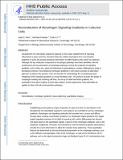Reconstitution of Morphogen Signaling Gradients in Cultured Cells
Author(s)
Kim, Julia S.; Pineda, Michael; Li, Pulin
DownloadAccepted version (846.6Kb)
Open Access Policy
Open Access Policy
Creative Commons Attribution-Noncommercial-Share Alike
Terms of use
Metadata
Show full item recordAbstract
Development of multicellular organisms depends on the proper establishment of signaling information in space and time. Secreted molecules called morphogens form concentration gradients in space and provide positional information to differentiating cells within the organism. Although the key molecular components of morphogen pathways have been identified, how the architectures and key parameters of morphogen pathways control the properties of signaling gradients, such as their size, speed, and robustness to perturbations, remains challenging to study in developing embryos. Reconstituting morphogen gradients in cell culture provides an alternative approach to address this question. Here we describe the methodology for reconstituting Sonic Hedgehog (SHH) signaling gradients in mouse fibroblast cells. The protocol includes the design of morphogen sending and receiving cell lines, the setup of radial and linear gradients, the quantitative time-lapse imaging, and the data analysis. Similar approaches could potentially be applied to other cell–cell communication pathways.
Date issued
2020-12Department
Whitehead Institute for Biomedical Research; Massachusetts Institute of Technology. Department of BiologyPublisher
Springer US
Citation
Kim, Julia S., Pineda, Michael and Li, Pulin. 2020. "Reconstitution of Morphogen Signaling Gradients in Cultured Cells." 2258.
Version: Final published version
ISSN
1064-3745
1940-6029